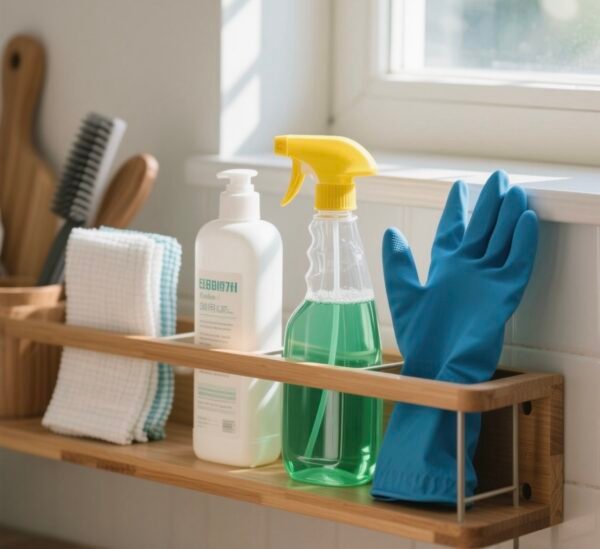In modern homes, cleaning is no longer just about removing visible dirt. People expect their cleaning products to do more – to eliminate invisible threats like bacteria, fungi, and viruses, and to keep surfaces hygienic for longer. This is where inorganic antimicrobial agents come into play, becoming an integral part of advanced household cleaning formulations.
In this article, let’s explore what these agents are, how they work, and why they make your home a safer place.
The Rising Demand for Antimicrobial Cleaning Solutions
The COVID-19 pandemic fundamentally shifted consumer attitudes towards hygiene. Surveys show that:
- Over 70% of consumers now seek cleaning products with antimicrobial or antibacterial claims.
- Many people worry not just about cleaning, but also about surface recontamination between cleaning cycles.
As a result, cleaning product manufacturers are turning to inorganic antimicrobial additives to enhance both immediate disinfection power and long-term antimicrobial protection.
What Are Inorganic Antimicrobial Agents?
Inorganic antimicrobial agents are metal-based compounds with strong and broad-spectrum antimicrobial effects. The most common include:
1. Silver (Ag)
Silver ions disrupt bacterial cell membranes, block respiratory enzymes, and inhibit replication. Silver has been used historically in wound care and water storage for its strong antibacterial properties.
2. Copper (Cu)
Copper ions penetrate microbial cells, damage proteins and DNA, and generate reactive oxygen species. Its antiviral and antifungal efficacy complements its antibacterial action.
3. Zinc (Zn)
Zinc ions interfere with bacterial metabolism and enzyme function, offering mild but broad-spectrum antimicrobial protection, often used alongside silver and copper.
How Are These Agents Used in Household Cleaning Products?
Unlike organic biocides, which may degrade quickly, inorganic antimicrobial agents remain stable and active for extended periods. They are formulated into cleaning products in two primary ways:
🧴 1. As Active Cleaning Ingredients
Silver, copper, or zinc-based compounds are directly mixed into sprays, wipes, or cleaning gels. They:
- Provide rapid antimicrobial action upon application.
- Leave residual antimicrobial activity on surfaces after cleaning, creating a protective barrier.
For example, a surface spray containing silver ions continues to inhibit bacterial growth even hours after wiping.
🧽 2. Embedded Into Cleaning Tools
Sponges, scrubbers, and cleaning cloths themselves can harbor bacteria, leading to odors or contamination spread. Manufacturers integrate antimicrobial agents into:
- Sponge foam
- Microfiber cloth fibers
- Brush bristles
This prevents bacterial growth within the cleaning tool, keeping it hygienic between uses and extending its lifespan.
Mechanism of Action: How Do They Kill Bacteria?
The effectiveness of inorganic antimicrobial agents lies in their multi-targeted attack mechanisms:
- Ion Release
Metal ions are released slowly from the cleaning product or tool surface. - Cell Membrane Disruption
These ions bind to bacterial cell walls, destabilizing their structure and causing leakage of essential cell contents. - Enzyme Inhibition
Metal ions block critical bacterial enzymes, stopping respiration and energy production. - DNA Binding
Some metal ions penetrate further to bind bacterial DNA, preventing replication.
Because of these multiple mechanisms, bacteria find it hard to develop resistance against inorganic antimicrobials.
Advantages Over Organic Antimicrobials
| Feature | Inorganic Agents | Organic Agents |
|---|---|---|
| Heat Stability | Stable at high temperatures | Often degrade under heat |
| Volatility | Non-volatile, no harmful fumes | Some may emit odors or fumes |
| Longevity | Long-lasting ion release | Effectiveness declines quickly |
| Resistance Potential | Low potential for bacterial resistance | Higher risk of resistant strains |
Applications in Common Household Products
🏠 1. Surface Disinfectant Sprays
Sprays containing silver or copper ions offer immediate disinfection and continued antimicrobial protection on countertops, sinks, and toilet surfaces.
🧼 2. Antibacterial Cleaning Wipes
Wipes infused with silver-based antimicrobials maintain freshness in sealed packs and leave surfaces with residual antimicrobial activity.
🧽 3. Kitchen Sponges and Cloths
Antimicrobial-treated sponges stay odor-free and hygienic longer, reducing the need for frequent replacements.
🚿 4. Bathroom Cleaners
Mold and mildew thrive in moist bathrooms. Zinc-based antimicrobial agents in tile and grout cleaners inhibit fungal growth, preventing unsightly stains and health hazards.
Are These Agents Safe for Home Use?
Yes. Reputable manufacturers use inorganic antimicrobial agents within safety limits regulated by global authorities such as:
- US EPA (Environmental Protection Agency)
- US FDA (Food and Drug Administration)
- European Chemicals Agency (ECHA)
They are formulated to release ions at levels effective against microbes but safe for human contact, without risk of inhalation toxicity or skin irritation when used as directed.
Environmental Impact Considerations
Modern inorganic antimicrobials are designed for minimal environmental impact:
- Low dosage effectiveness reduces total chemical load.
- Non-volatile nature avoids air pollution or harmful fumes.
- Long-lasting action means fewer product applications needed, lowering packaging and waste.
However, responsible disposal and adherence to usage guidelines remain important to ensure environmental safety.
The Future: Smarter and Greener Cleaning
The next frontier in household cleaning product development includes:
- Multi-metal synergistic formulations combining silver, copper, and zinc for broader efficacy.
- Smart-release systems that adjust ion release rates based on surface moisture or temperature.
- Biodegradable carriers for antimicrobial agents to enhance eco-friendliness without compromising effectiveness.
Final Thoughts
Cleanliness is not just about appearance – it’s about ensuring health and safety for every family member. By incorporating inorganic antimicrobial agents, cleaning products gain powerful and lasting antimicrobial properties, offering peace of mind far beyond what traditional cleaning alone can achieve.
As consumers increasingly prioritize health and hygiene, antimicrobial-enhanced household cleaning solutions are set to become the new standard, ensuring that every wipe, scrub, and spray keeps your home truly clean – not just today, but long after you finish cleaning.
✉️ Interested in Developing Antimicrobial Cleaning Solutions?
We offer tailored inorganic antimicrobial formulations compatible with household cleaning products and tools.
Contact us today to explore how we can help you deliver safer, longer-lasting hygiene to households worldwide.


-300x210.jpg)
